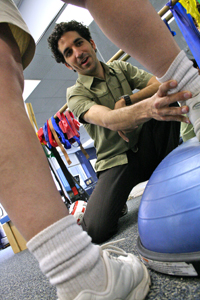Studying Falls Key to Reducing Disability Among Elderly
 |
| Physical therapist Evan McLeod introduces a patient to an excerise designed to improve balance. |
Older people typically fall due to a combination of factors including poor muscle strength, lack of balancing abilities, and using medications that have side effects such as drowsiness and dizziness. Poor eyesight and the weakening effects of certain chronic diseases may also contribute. Given that complications of falls in people 65 years old and older are the leading cause of death due to injury, studying falls and why they happen is important.
Researchers in the Department of Physical Therapy and Human Movement Sciences at Northwestern University’s Feinberg School of Medicine are focusing on specific aspects of falls using experimental, modeling, and interventional approaches. Mark W. Rogers, PhD, PT, associate professor and associate chair for post-professional education, says, “We study the neuromechanical mechanisms of lateral balance because we’ve demonstrated through results from our earlier research that older people tend to be especially vulnerable to falling sideways.”
Older people also have changes in their “stepping response,” Dr. Rogers says, which is an unconscious reflex people have to right themselves by taking a series of small steps. Sometimes older people employ small, cross-over steps when they begin to fall to the side. This may cause their legs to collide, making a fall more likely. In contrast, younger people tend to catch themselves before they fall by spreading their feet and planting them widely apart. This planted stance gives a biomechanically stable base of support for the body.
The National Institute on Aging has supported Dr. Rogers’ work. This year he reported on other aspects of his balance research in “Choice Stepping Response and Transfer Times: Effects of Age, Fall Risk, and Secondary Tasks,” which was published in the Journal of Gerontology. Dr. Rogers and colleagues investigated how a competing cognitive task and an obstacle to stepping affected phases of choice reaction times in adults ages 23â40, adults 75â86 with low risk of falls, and adults 78â88 years with high risk of falls. Measurements for each of four conditions were taken, and various test errors by the subjects were recorded. The researchers concluded that when compared with young people, older people, especially those at high risk of falling, have an impaired ability to begin and take quick, accurate, voluntary steps. This was especially true in situations where their attention was purposely divided.
“Older adults who have fallen are often very apprehensive about falling again,” says Evan J. McLeod, PT, DPT, a graduate of Northwestern’s Doctor of Physical Therapy Program. On staff at a Chicago rehabilitation center, McLeod uses specific exercises to rehabilitate patients with various physical problems including those related to balance. “Building trust with each individual and giving encouragement is especially necessary because to improve balance, the therapist has to push each person just beyond his or her limitations,” says McLeod. “I reassure them by discussing the safety training I’ve had, such as techniques in guarding [assuming positions to physically support the person as necessary as the client attempts an exercise].” He assists clients in performing low-difficulty exercises while gradually decreasing the body’s base of support, for example, changing the standing surface from a hard floor to a foam square. Finally, he may alter the visual environment so the person has to pay close attention to sensory cues the body gives for balancing.
Research about falls and the rehabilitation of those who have fallen are pursued with the hope of offering better preventive solutions.






